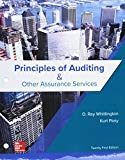
Concept explainers
a.
Calculate the
a.
Answer to Problem 47P
The required sample size is 25 accounts using mean-per unit sampling.
Explanation of Solution
Sample size:
The sample size is the portion of the total population that represents the total population. The auditor conducts sampling test on the selected sample. Large sample size would represent the population more accurately but considering a large sample size would be a complex and expensive process. The auditor should select the sample size that would represent the entire population precisely and accurately.
Mean-per-unit sampling:
It is a technique of classical variables sampling. Mean-per-unit sampling works on the assumption that the audited mean of the sample size will represent the actual audited mean of the population. First, the mean of the sample size is calculated then the estimation for the value of the population is calculated by multiplying the calculated sample mean to the total of the items in the population. The difference between the value of the population calculated under mean-per unit sampling and the book value of the client is the projected misstatement.
Calculate the sample size for the population of Company J:
Thus, the required sample size is 25 accounts using mean-per unit sampling.
b.
Calculate the projected misstatement and provide an opinion whether the materially misstated account should be accepted or not.
b.
Answer to Problem 47P
The projected misstatement is $30,000 and the auditor should accept that the account is not materially misstated.
Explanation of Solution
Material misstatement:
Risk assessment procedures performed by the auditors is aimed at identifying any misstated information in the financial statements that will lead to any fraud if not audited then it is called the material misstatement of financial records. Some matters are indispensable for the fair representation of the financial statements and to keep the financial statements free from any such material misstatement audit is performed.
Determine the projected misstatement in the population for Company J:
Thus, the projected misstatement is $30,000.
Working note 1:
Calculate the audited value:
Provide an opinion whether the materially misstated account should be accepted or not:
Calculate the adjusted allowance for sampling risk:
Thus, the allowable sampling risk is $100,000.
Suggest whether the auditor should accept the population or not:
The auditor should accept that the account is not materially misstated.
Calculate the confidence internal:
As the upper limit of confidence interval ($130,000) is not exceeding the tolerable misstatement (182,000) then the auditor should accept the population. The chances of excess misstatement are low with this population.
Thus, the auditor should accept that the account is not materially misstated.
c.
Calculate the projected misstatement and provide an opinion whether the materially misstated account should be accepted or not.
c.
Answer to Problem 47P
The projected misstatement is $30,000 and the auditor should accept that the account is not materially misstated.
Explanation of Solution
Material misstatement:
Risk assessment procedures performed by the auditors is aimed at identifying any misstated information in the financial statements that will lead to any fraud if not audited then it is called the material misstatement of financial records. Some matters are indispensable for the fair representation of the financial statements and to keep the financial statements free from any such material misstatement audit is performed.
Determine the projected misstatement in the population for Company J:
Thus, the projected misstatement is $30,000.
Provide an opinion whether the materially misstated account should be accepted or not:
Calculate the adjusted allowance for sampling risk:
Thus, the allowable sampling risk is $116,400.
Suggest whether the auditor should accept the population or not:
The auditor should accept that the account is not materially misstated.
Calculate the confidence internal:
As the upper limit of confidence interval ($146,400) is not exceeding the tolerable misstatement (182,000) then the auditor should accept the population. The chances of excess misstatement are low with this population.
Thus, the auditor should accept that the account is not materially misstated.
Want to see more full solutions like this?
Chapter 9 Solutions
GEN COMBO LL PRINCIPLES OF AUDITING & OTHER ASSURANCE SERVICES; CONNECT AC
- General Accounting Questionarrow_forwardNDB Company has a factory with fixed costs of $650,000 and a production capacity of 225,000 units annually. Its product sells with a 36% contribution margin. The target profit is $470,000. At full production, what does the selling price per unit need to be? Show your complete solution.arrow_forwardFinancial accountingarrow_forward
- On July 1, 2024, Lakeside Fitness Center received $48,000 in advance for a 24-month membership program. By December 31, 2024, six months of membership services have been provided. What adjusting entry should be recorded on December 31, 2024?arrow_forwardPlease solve this General accounting questions step by steparrow_forwardDetermine the direct materials and conversion costs per equivalent unit? Accountingarrow_forward
 Auditing: A Risk Based-Approach (MindTap Course L...AccountingISBN:9781337619455Author:Karla M Johnstone, Audrey A. Gramling, Larry E. RittenbergPublisher:Cengage Learning
Auditing: A Risk Based-Approach (MindTap Course L...AccountingISBN:9781337619455Author:Karla M Johnstone, Audrey A. Gramling, Larry E. RittenbergPublisher:Cengage Learning
